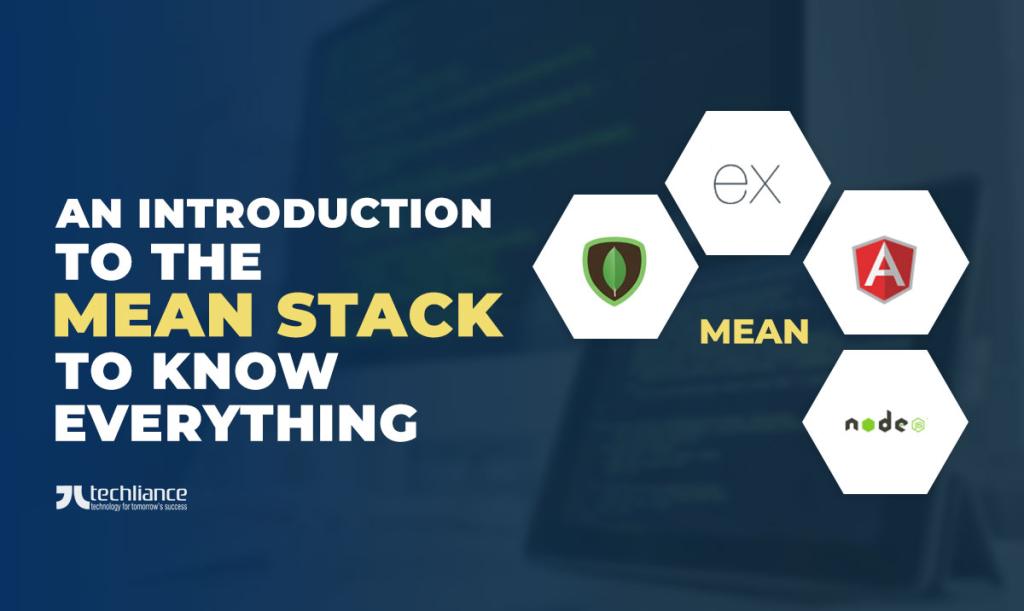Technology is transforming businesses and everyday lives globally and in the USA. In the same manner, computer programming and tech stacks are playing a big part in this evolution. Comparisons like the MEAN stack vs MERN stack let you choose a toolset for building web apps easily in 2024.
Businesses are becoming tech-savvy in figuring out the importance of creating apps that resonate with users. To have market success, you need to develop an app that ticks all the boxes. Your app must have core factors like great user-centricity, holistic design, efficiency, and seamlessness.
Getting straight to the point, our discussion is all about comparing MEAN and MERN stacks. We are trying to figure out which one is better for developing an awesome product or application. Keep reading this insightful post to learn with us about this matter.

Defining the MEAN stack
In a nutshell, MEAN stack is a software stack comprising MongoDB, Express.js, Angular, and Node.js technologies. It is a cool approach to web development through JS-driven technologies for the creation of robust websites and applications. Most of all, it is a free, and open-source tech stack with a wide array of built-in testing tools.
Let’s have a closer look at the technologies that constitute the MEAN stack.
- MongoDB — It is a cross-platform, document-oriented, and scalable NoSQL database program. MongoDB saves high volumes of data in the binary JSON format and even extends cloud functionalities. This highly flexible database program helps in the creation of tables, schemas, etc.
- Express.js — It’s a backend web application framework for APIs that allows the creation of single, and multi-page applications. Express.js is layered on top of Node.js to support the server-side framework and brings ease in writing the backend code and logic. This modular framework supports middleware to promote code reusability. The result is better design of APIs and web applications.
- Angular.js — As an open-source frontend JavaScript framework, Angular.js is suitable for user interface development with MCV design capabilities.
- Node.js — It is a JS-based execution environment on the server side for developing networking and server-side applications. Node.js is the run-time environment to run code on the server. With the Node Pack Manager (NPM), thousands of free-to-download and use public/private node modules are available.

Why choose MEAN stack?
Internationally, MEAN stack remains a popular choice for web development. For starters, it allows greater flexibility toward code transfer within other frameworks. Through the MEAN stack, you can develop robust web applications with ease.
Moreover, the great community support of the MEAN stack is a huge factor. Your peers under the JS umbrella help you resolve the errors where you are stuck. Also, they pitch you small-to-medium scale projects for higher learning and a possible chance at making money.
The best part about using MEAN stack development is it extends over a full development cycle from client to server. So, you get to experience the whole nine yards. It is a great playground for front-end development, enabling companies to create powerful UI/UX experiences that entice users.
Advantages of MEAN stack
MEAN stack has immense potential which is why businesses understand its value for website application development during 2024. Through the MEAN stack, you can build web applications using a single computer language (that is JavaScript). It even allows developers to deploy web applications immediately on a server without having to deploy on a standalone server.
This stack provides a simple, open-source, and free solution to build robust applications. It is a time-saving stack that allows access to modules and libraries without requiring developers to build modules from scratch. Also, it presents the aspect of cost-effectiveness as companies only then need to hire MEAN stack developers.
There is an automatic testing feature with notifications to enable developers to produce bug-free applications. The web applications built through the MEAN stack are scalable and easy to update with room for adding additional features. It is highly compatible with the cloud and has easier developing, testing, and deployment phases.
Angular and Node.js both use JSON which allows formatting, storing, and transferring data without any hassle. JavaScript is a universal language for coding with huge patronage across the world from developers.
Disadvantages of MEAN stack
Usually, developers favor the MEAN stack to create small to medium-magnitude products. In case of heavy loading, MongoDB may cause some loss of records. MEAN stack developers are in high demand and cost more.
Who is using the MEAN stack?
In the technology industry, the MEAN stack has a huge patronage. Some extremely popular companies are using the stack to develop their products. Some examples of applications made through the MEAN stack include the following.
- Gmail
- PayPal
- YouTube
- The Weather Channel
- Forbes
- Automatic Data Processing
- Trello

Defining the MERN stack
Simply put, the MERN stack is an application stack that is made of MongoDB, Express.js, React.js, and NodeJS. This is an alternative to the MEAN stack, where Angular replaces React. It makes the development process smooth and easy in comparison.
Let’s take a look at the lone different constituent of the MERN stack from the MEAN stack.
- React.js — It is the front-end JavaScrript library that enables quick handling of data and simplifies the development of single-page/muti-page applications. ReactJS allows the creation of UI components and the editing/refreshing of pages without reloading them. Also, it enables you to use the React Native framework to build mobile applications.

Why choose the MERN stack?
Remember that the MERN stack has one competitive advantage: React.js which gives the best UI layer abstraction. It is so seamless for coding that it allows collecting dynamic user interfaces readily within the library. Also, it is ideal for controlling and updating large and dynamic JSON data for smoothly navigating between front-end and back-end.
Advantages of MERN stack
These are some of the benefits of the MERN stack within 2024.
- MERN stack enables companies to create robust web apps. Likewise, all technologies under this stack come with many tools to help you build innovative web applications. The stack also improves coding efficiency which helps in the faster development of products.
- The open-source technology of the MERN stack also means that there is no vendor lock-in. Therefore, if you ever decide to migrate or update down the line: it would not be very complicated. MERN stack has free templates available online which enables developers to save three times to create a customizable solution.
- You can simply download an off-the-shelf solution through the templates. Also, these platforms have online communities to get the answers for faster solutions whenever you’re stuck in any problem. With free customizable templates, you employ a plug-and-play approach to incorporate these platforms and come up with great solutions.
- MERN stack provides the full stack development approach, which enables building both the front-end and the back-end of the application. Therefore, it is a fine mix between UI design and software engineering. You can hire MERN stack developers to save you from hiring separate front-end and back-end developers that cost you more.
- The best part is that whatever you are planning on developing, is probably something that is already there. You just have to find it online and then begin your customization. Accordingly, the ease of use is tremendous.
- The documentation is so logically written that beginner-level developers can quickly grasp the concept and start with their tasks. Most of all, the tools have a minimalistic nature which encourages developers to approach and then learn about them. That’s why the majority of newbie developers prefer learning the MERN stack and beginning their journey in web development.
- MERN stack has a wide community support, that makes it easier to seek the answer you are looking for. The developers within the community are well-knit and easily approachable through different forums. There you can place your questions, join a discussion, and learn something new.
- React is all about providing the perfect experience to users through robust and secure applications. MERN stack allows companies to create native-like applications that can function on various platforms. Applications built on the MERN stack can work without any halts or interruptions.
Disadvantages of MERN stack
A few downsides of the MERN stack are the following.
- MERN stack is not very suitable for multi-page applications.
- It can have lower developer productivity during upgrading, because React code may require more effort from the developer.
- With cross-collaboration between different stakeholders, the development of large-scale applications gets cumbersome.
- It does not present common coding eros at the coding stage.
Who is using the MERN stack?
Here are the apps that are built through the MERN stack.
- Skype
- Netflix
- Dropbox

Differences between the MEAN stack and the MERN stack
These are the differences between the MEAN and MERN stacks.
- The main difference is the client-side technology, as the MEAN stack uses Angular while the MERN stack has React.
- MEAN stack is backed by Google, whereas, MERN stack is backed by Facebook.
- In terms of UI rendering, React (and thus the MERN stack) performs better than Angular (and thus the MEAN stack).
- MERN stack (due to React) is easy to learn in comparison to the MEAN stack (due to Angular).
- MEAN is an ideal choice for enterprise-level applications, while MERN is for the quick development of smaller applications.
- MERN enables code at a quicker speed, while MERN maintains abstraction in coding and manages files too.
- MEAN has support for multiple third-party libraries, whereas MERN requires additional libraries to support such calls.
- Data flow in MEAN is bidirectional where the model state automatically changes with the UI. Whereas, MERN has a unidirectional data flow where the model state changes after the UI is changed.

Conclusion
Presently, it is crucial to pick the right stack that serves the purpose. MEAN stack and MERN stack receive great praise in the market for their outstanding performance. After all, they both are assisting developers in building some of the most popular products through 2024.
Both MEAN and MERN stacks are highly reliable as technology suites. It’s not easy to pick one from the other, as both have value in terms of the business use cases. Your project requirements and the long-term plan are the two deciding factors for selecting the appropriate toolset.
Do you want to create a single-page app that users like? You may need complete consultancy in figuring out the right technology stack for your web project. We at Techliance provide 360-degree services from understanding your requirements to developing a high-performing product.
It is only the beginning, as we provide stellar software development services at the most cost-effective rates. And that too at various outsourcing models. Contact us to know more, as we are just a click away.
About the author




